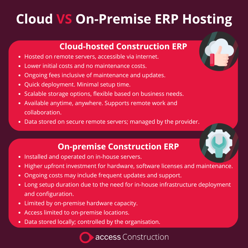On-Premise vs Cloud – Which is the Best Way to Host ERP Software?
As industries shift towards a digital transformation, choosing the right ERP software for your business will help you stay ahead of the curve.
In today's rapidly evolving business landscape, the way you install your software has become more critical than ever. In this guide, we dissect the complexities of on-premises versus cloud hosting, offering insights into deployment, costs, security, and more.
Contents
- Hosting ERP Software
- What is On-Premise ERP Hosting?
- What is Cloud-Based ERP Hosting?
- On-Premise vs Cloud ERP Hosting – The Key Differences
- On-Premise vs Cloud – Deployment
- On-Premise vs Cloud – Costs
- On-Premise Vs Cloud – Security
- Pros and Cons of On-Premise-Hosted ERP
- Pros and Cons of Cloud-Hosted ERP
Hosting ERP Software
Selecting an appropriate hosting solution is a critical aspect of acquiring and implementing ERP software in the construction sector.
Traditionally, on-premise hosting was the go-to method for hosting software, with companies housing their ERP systems locally on their own servers.
In recent years, however, the advent of cloud computing has revolutionised the hosting landscape, offering a flexible and scalable alternative. The shift towards cloud hosting has been fuelled by its numerous benefits, including reduced infrastructure costs, increased accessibility, and enhanced scalability.
This transition reflects broader trends in the industry towards digitisation and the adoption of agile, cloud-based solutions. With companies striving to stay ahead in an increasingly competitive environment, many are now rethinking their infrastructure, consolidating disparate software, and moving towards more digital-first set-ups.
According to a recent study by Barracuda Networks, over 76% of organisations in Australia are projected to transition their IT infrastructure to the public cloud within the next five years.

What is On-Premise ERP Hosting?
On-premise ERP hosting involves deploying and managing the ERP software within your organisation’s physical infrastructure.
In this model, the software is installed and maintained on local servers located on-site at the company's premises. This traditional approach affords companies direct control over their ERP system, allowing for customisation, data management, and security measures tailored to their specific requirements.
On-premise hosting typically requires a substantial upfront investment in hardware, software licenses, and IT infrastructure. Additionally, organisations are responsible for ongoing maintenance, updates, and security patches, necessitating dedicated IT resources.
While on-premise hosting offers a higher level of control and security, it can also be resource-intensive and inflexible, particularly in adapting to evolving companies needs and technological advancements.
Despite these challenges, some organisations may opt for on-premise hosting due to regulatory compliance requirements, data sensitivity concerns, or a preference for maintaining complete control over their IT environment.
What is Cloud-Based ERP Hosting?
Cloud-based ERP hosting involves securely hosting the software on remote servers, which are accessible via an internet connection.
The rising star of ERP, cloud-based hosting, offers unparalleled flexibility and scalability to companies of all sizes. Leveraging leading cloud systems, cloud-based ERP solutions host company data and infrastructure on secure remote servers, accessible from any location and any device with an internet connection. cloud-based ERP solutions host company data and infrastructure on secure remote servers, accessible from any location and any device with an internet connection.
This innovative approach has gained traction in recent years as construction companies worldwide migrate to cloud-hosted alternatives.
Recent reports support the rising popularity of cloud-based services, with IDC forecasting a substantial surge in spending on public cloud services in Australia. In their recent report in partnership with Microsoft, they estimated an 83% increase in size, projected to elevate spending from A$12.2 billion in 2022 to A$22.4 billion.
Cloud-based ERP systems are inherently scalable, seamlessly accommodating company growth without the need for extensive hardware investments. They also enhance operational efficiencies as teams can securely access critical data and applications from any device, facilitating real-time collaboration and information sharing across project stakeholders.
Cloud-based hosting models most commonly involve reduced upfront costs when compared to on-premise hosting and provide predictable, subscription-based pricing structures.
But let’s dig into the key difference between cloud-hosted and on-premise ERP hosting in more detail.

On-Premise vs Cloud ERP Hosting – Key Differences
|
Category |
Cloud-Hosted Construction ERP |
On-Premise Construction ERP |
|
Definition |
Centrally hosted on remote servers, and accessible via the internet. |
Installed and operated on the company's in-house servers.
|
|
Upfront Costs |
Lower initial costs and no maintenance costs. |
Higher upfront investment for hardware, software licenses, and maintenance. |
|
Cost to Upkeep |
Ongoing subscription fees, usually inclusive of maintenance and updates. |
Ongoing costs may include frequent updates and support. |
|
Time to Set-Up |
Quick deployment as infrastructure is managed by the provider and no hardware is required to be installed in your company. Minimal setup time. |
Longer setup duration due to the need for in-house infrastructure deployment and configuration. This alone, could take months of set-up time. |
|
Maintenance |
Hardware and software maintenance can be outsourced to a provider, reducing your IT requirements and expenditures. |
Manual upgrades and services are required, which can incur huge costs in the long-run and extensive downtime. |
|
Storage Capabilities |
Scalable storage options, allowing flexibility based on business needs. |
Limited by on-premise hardware capacity. Scalability may require additional investment such as in software or additional hardware. |
|
Accessibility |
Anytime, anywhere access via the internet. Supports remote work and collaboration through purpose-built mobile apps. |
Access limited to on-premise locations where the software has been installed initially, potentially requiring VPN for remote access. |
|
Security |
Data stored on secure remote servers ; managed by the provider. |
Data stored locally; controlled by the organisation. |
|
Customisation |
More limited customisation; standardized configurations. |
Highly customisable; tailored to specific needs. |

On-Premise vs Cloud – Deployment
Making an informed choice on whether to invest in on-premise or cloud-hosted ERP software requires you to understand how they are deployed within the company. Let’s look at each in turn.
On-Premise Deployment:
In on-premise deployment, ERP software is installed and managed locally within your organisation’s infrastructure. This approach offers a high level of control and customisation, allowing tailored configurations to meet specific business needs.
However, it requires significant upfront investment in hardware, software licenses, and IT expertise. Therefore, deploying on-premise ERP will require a breadth of talent and skill within the company before this can be considered.
Finally, scalability can also be limited. Expansion often entails additional hardware purchases and upgrades. Therefore, whilst on-premise deployment provides direct oversight of data management processes, business managers should be aware that it may require extensive resources for implementation and its ongoing management.
Cloud Deployment:
Cloud deployment shifts ERP hosting to remote servers managed by third-party providers. This model offers greater agility and scalability, with resources accessible from any location with internet connectivity. The subscription-based pricing reduces upfront costs and provides predictable expense structures, alongside continued support from dedicated external teams.
Cloud solutions facilitate rapid deployment, automatic updates, and seamless scalability, making them ideal for businesses seeking flexibility and cost-efficiency. Additionally, cloud hosting enhances accessibility and enables remote work capabilities, fostering collaboration and productivity across teams.
On-Premise vs Cloud – Costs
On-Premise Costs:
On-premise ERP deployment typically involves substantial upfront costs, including hardware procurement, software licenses, and infrastructure setup.
Normally, organisations must invest in servers, networking equipment, and data storage systems, alongside hiring IT personnel to manage and maintain the infrastructure. In some instances, this resource already exists within the business helping to alleviate costs, however, usually additional resource is required.
Additionally, there are ongoing expenses for software updates, security measures, and hardware upgrades to ensure system performance and reliability. These capital expenditures can strain budgets and require careful financial planning to mitigate risks and ensure a return on investment over time.
Cloud Costs:
In contrast, cloud-based ERP solutions operate on a subscription-based pricing model, offering more predictable and manageable costs.
Companies pay a recurring fee based on usage or the number of licenses required, typically on a monthly or annual basis. This subscription model eliminates the need for upfront hardware investments and reduces ongoing maintenance expenses, as updates are carried out externally.
Cloud providers handle infrastructure management, including software updates, security patches, and performance optimisation, alleviating the burden on your internal IT teams. Additionally, cloud hosting offers scalability, allowing companies to adjust resources based on demand without incurring significant additional costs.
It’s important to note however, that implementation may still require significant resource in the short-term. This could be a significant upfront cost as well as requiring a dedicated number of your team to carry out project management and training.

On-Premise vs Cloud – Costs
Whilst it would be impossible to exact specific costs for implementing each type of ERP; understanding the associated costs with on-premise and cloud-hosted ERP will help during your decision-making process.
On-Premise Hosting Costs:
On-premise ERP deployment typically involves substantial upfront costs, including hardware procurement, software licenses, and infrastructure setup.
Normally, organizations must invest in servers, networking equipment, and data storage systems, alongside hiring IT personnel to manage and maintain the infrastructure. In some instances, this resource already exists within the business helping to alleviate costs, however, usually additional resource is required.
Additionally, there are ongoing expenses for software updates, security measures, and hardware upgrades to ensure system performance and reliability. These capital expenditures can strain budgets and require careful financial planning to mitigate risks and ensure a return on investment over time.
Cloud Hosting Costs:
In contrast, cloud-based ERP solutions operate on a subscription-based pricing model, offering more predictable and manageable costs.
Companies pay a recurring fee based on usage or the number of licenses required, typically on a monthly or annual basis. This subscription model eliminates the need for upfront hardware investments and reduces ongoing maintenance expenses, as updates are carried out externally.
Cloud providers handle infrastructure management, including software updates, security patches, and performance optimization, alleviating the burden on your internal IT teams. Additionally, cloud hosting offers scalability, allowing companies to adjust resources based on demand without incurring significant additional costs.
It’s important to note, however, that implementation may still require significant resources in the short term. This could be a significant upfront cost as well as requiring a dedicated number of your team to carry out project management and training.
On-Premise Vs Cloud – Security
On-Premise Security:
On-premise ERP hosting grants businesses direct control over their data security measures. With data stored locally on company-owned servers, companies can implement customised security protocols tailored to their specific requirements.
However, this approach also places the onus on internal IT teams to manage and monitor security measures, including firewalls, encryption, and access controls.
It’s important to remember that whilst on-premise hosting offers a perceived sense of security due to physical proximity to data, it may be susceptible to risks such as hardware failure, natural disasters, or unauthorised access if security measures are not adequately implemented and maintained.
Cloud Security:
Contrary to common misconceptions, cloud hosting can provide enhanced security measures, leveraging advanced encryption protocols, multi-factor authentication, and continuous monitoring to safeguard data integrity and privacy.
Cloud providers invest heavily in infrastructure security, employing dedicated teams of experts to manage and protect data centres against cyber threats and unauthorised access. Additionally, cloud hosting offers built-in redundancy and disaster recovery capabilities, mitigating risks and downtime associated with hardware failures or environmental disasters.
Some leading construction ERP software also partner with leading cloud providers to provide unmatched encryption and security to their customers.
By leveraging these leading cloud-based ERP solutions, construction companies can benefit from enterprise-grade security measures without the burden of managing and maintaining on-premise infrastructure, ensuring comprehensive protection against evolving cyber threats.
Pros and Cons of On-Premise-Hosted ERP
|
Pros and Cons of On-Premise-Hosted ERP |
|
|
PROS |
CONS |
|
|
|
|
|
|
|
|
|
|
|
|
|
|
Pros and Cons of Cloud-Hosted ERP
|
Pros and Cons of Cloud-Hosted ERP |
|
|
PROS |
CONS |
|
|
|
|
|
|
|
|
|
|
|
|
|
|
Access Coins, Cloud-Hosted Construction ERP
Built for the construction sector, Access Coins ERP is a leading end-to-end business management solution. Helping you manage risks, save time and increase profitability, Access Coins ERP is built and hosted on the cloud.
Unlike other ERP systems, Access Coins is an entirely construction-specific software built for the specific operational and regulatory needs of construction companies.
Ready to transform your construction business? Arrange a demo with our specialists today to see the software in action and learn how Access Coins ERP can transform your business.


